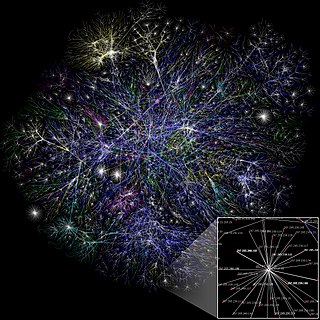Related Research Articles
Communication is the act of conveying meanings from one entity or group to another through the use of mutually understood signs, symbols, and semiotic rules.
Mass media refers to a diverse array of media technologies that reach a large audience via mass communication. The technologies through which this communication takes place include a variety of outlets.

Network topology is the arrangement of the elements of a communication network. Network topology can be used to define or describe the arrangement of various types of telecommunication networks, including command and control radio networks, industrial fieldbusses and computer networks.

Broadcasting is the distribution of audio or video content to a dispersed audience via any electronic mass communications medium, but typically one using the electromagnetic spectrum, in a one-to-many model. Broadcasting began with AM radio, which came into popular use around 1920 with the spread of vacuum tube radio transmitters and receivers. Before this, all forms of electronic communication were one-to-one, with the message intended for a single recipient. The term broadcasting evolved from its use as the agricultural method of sowing seeds in a field by casting them broadly about. It was later adopted for describing the widespread distribution of information by printed materials or by telegraph. Examples applying it to "one-to-many" radio transmissions of an individual station to multiple listeners appeared as early as 1898.
A virtual community is a social network of individuals who connect through specific social media, potentially crossing geographical and political boundaries in order to pursue mutual interests or goals. Some of the most pervasive virtual communities are online communities operating under social networking services.
Agenda-setting describes the "ability to influence the importance placed on the topics of the public agenda". Agenda-setting is the creation of public awareness and concern of salient issues by the news media. The study of agenda-setting describes the way media attempts to influence viewers, and establish a hierarchy of news prevalence. Nations with more political power receive higher media exposure. The agenda-setting by media is driven by the media's bias on things such as politics, economy and culture, etc.
The spiral of silence theory is a political science and mass communication theory proposed by the German political scientist Elisabeth Noelle-Neumann. It states that a social group or society might isolate or exclude members due to the members' opinions. This stipulates that individuals have a fear of isolation. This fear of isolation consequently leads to remaining silent instead of voicing opinions. Media are an important factor that influences both the dominant idea and people's perception of what the dominant idea is. The assessment of one's social environment may not always correlate with reality.

The public sphere is an area in social life where individuals can come together to freely discuss and identify societal problems, and through that discussion influence political action. Such a discussion is called public debate and is defined as the expression of views on matters that are of concern to the public—often, but not always, with opposing or diverging views being expressed by participants in the discussion. Public debate takes place mostly through the mass media, but also at meetings or through social media, academic publications and government policy documents. The term was originally coined by German philosopher Jürgen Habermas who defined the public sphere as "made up of private people gathered together as a public and articulating the needs of society with the state". Communication scholar Gerard A. Hauser defines it as "a discursive space in which individuals and groups associate to discuss matters of mutual interest and, where possible, to reach a common judgment about them". The public sphere can be seen as "a theater in modern societies in which political participation is enacted through the medium of talk" and "a realm of social life in which public opinion can be formed".
Alternative media are media sources that differ from established or dominant types of media in terms of their content, production, or distribution. Sometimes the term independent media is used as a synonym, referencing independence from large media corporations, but this term is also used to indicate media enjoying freedom of the press and independence from government control. Alternative media does not refer to a specific format and may be inclusive of print, audio, film/video, online/digital and street art, among others. Some examples include the counter-culture zines of the 1960s, ethnic and indigenous media such as the First People's television network in Canada, and more recently online open publishing journalism sites such as Indymedia.
Representational state transfer (REST) is a software architectural style that defines a set of constraints to be used for creating Web services. Web services that conform to the REST architectural style, called RESTful Web services, provide interoperability between computer systems on the internet. RESTful Web services allow the requesting systems to access and manipulate textual representations of Web resources by using a uniform and predefined set of stateless operations. Other kinds of Web services, such as SOAP Web services, expose their own arbitrary sets of operations.
Mass communication is the process of imparting and exchanging information through mass media to large segments of the population. It is usually understood for relating to various forms of media, as these technologies are used for the dissemination of information, of which journalism and advertising are part. Mass communication differs from other forms of communication, such as interpersonal communication and organizational communication, because it focuses on particular resources transmitting information to numerous receivers. The study of mass communication is chiefly concerned with how the content of mass communication persuades or otherwise affects the behavior, the attitude, opinion, or emotion of the people receiving the information.
In marketing, promotion refers to any type of marketing communication used to inform target audiences of the relative merits of a product, service, brand or issue, most of the time is persuasive in nature. It helps marketers to create a distinctive place in customers' mind, it can be either a cognitive or emotional route. The aim of promotion is to increase awareness, create interest, generate sales or create brand loyalty. It is one of the basic elements of the market mix, which includes the four Ps, i.e., product, price, place, and promotion.

An advertising campaign is a series of advertisement messages that share a single idea and theme which make up an integrated marketing communication (IMC). An IMC is a platform in which a group of people can group their ideas, beliefs, and concepts into one large media base. Advertising campaigns utilize diverse media channels over a particular time frame and target identified audiences.
In media studies, mass communication, media psychology, communication theory, and sociology, media influence and media effects are topics relating to mass media and media culture's effects on individual or an audience's thoughts, attitudes, and behavior. Whether it is written, televised, or spoken, mass media reaches a large audience. Mass media's role and effect in shaping modern culture are central issues for study of culture.

A computer network is a group of computers that use a set of common communication protocols over digital interconnections for the purpose of sharing resources located on or provided by the network nodes. The interconnections between nodes are formed from a broad spectrum of telecommunication network technologies, based on physically wired, optical, and wireless radio-frequency methods that may be arranged in a variety of network topologies.

The International Communication Association (ICA) is an academic association for scholars interested in the study, teaching and application of all aspects of human and mediated communication. It began more than 60 years ago as a small organization of U.S. researchers and now is truly international with more than 4500 members in over 85 countries. Approximately two-thirds of members are academic scholars, professors, and graduate students, with the remaining members in government, the media, communication technology, business law, medicine and other professions. ICA also has 59 institutional members and a growing number (16) of association members.
Media is the communication outlets or tools used to store and deliver information or data. The term refers to components of the mass media communications industry, such as print media, publishing, the news media, photography, cinema, broadcasting, and advertising.

News is information about current events. This may be provided through many different media: word of mouth, printing, postal systems, broadcasting, electronic communication, or through the testimony of observers and witnesses to events.
Health communication is the study and practice of communicating promotional health information, such as in public health campaigns, health education, and between doctor and patient. The purpose of disseminating health information is to influence personal health choices by improving health literacy. Health communication is a unique niche in healthcare that allows professionals to use communication strategies to inform and influence decisions and actions of the public to improve health.
A group is a feature in many social networking services which allows users to create, post, comment to and read from their own interest- and niche-specific forums, often within the realm of virtual communities. Groups, which may allow for open or closed access, invitation and/or joining by other users outside the group, are formed to provide mini-networks within the larger, more diverse social network service. Much like electronic mailing lists, they are also owned and maintained by owners, moderators, or managers, who can edit posts to discussion threads and regulate member behavior within the group. However, unlike traditional Internet forums and mailing lists, groups in social networking services allow owners and moderators alike to share account credentials between groups without having to log into every group.
References
- Joseph Straubhaar; Robert LaRose; Lucinda Davenport (2015). Media Now: Understanding Media, Culture, and Technology. Cengage Learning. p. 51. ISBN 978-1-305-53385-1.